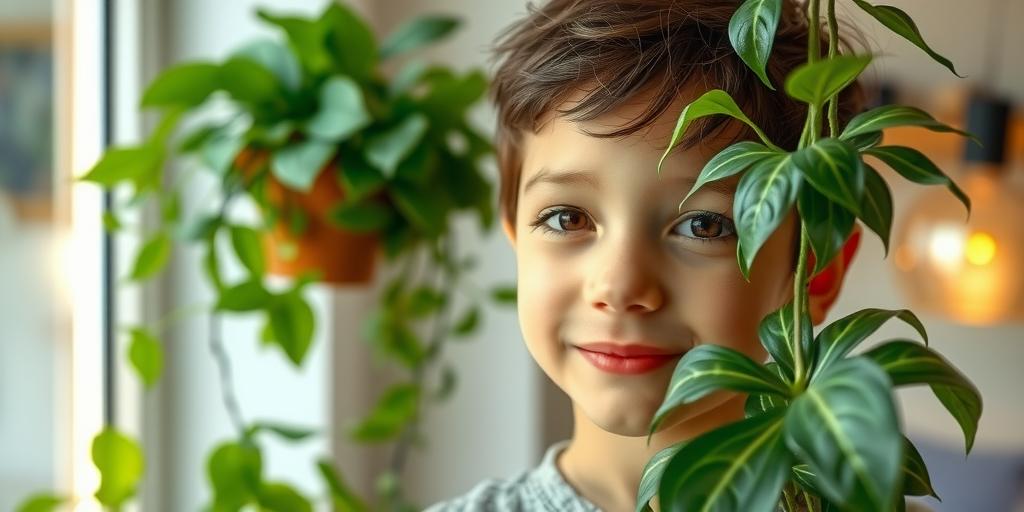
Top Non-Toxic Low Light Hanging Plants Safe for Kids’ Rooms
Looking for the best non-toxic, low-light hanging plants for your child’s room? Discover safe, kid-friendly options that purify the air and thrive in indirect light!
Introduction
Did you know indoor plants can improve air quality by up to 60%? If you’re a parent, you want greenery in your child’s space—but safety comes first! Not all plants are kid-friendly, and many require bright sunlight. That’s why we’ve curated a list of the best non-toxic, low-light hanging plants perfect for kids’ rooms. These plants are safe, easy to care for, and thrive even in dim corners. Let’s explore the top picks!
Why Choose Non-Toxic, Low-Light Hanging Plants for Kids’ Rooms?
Benefits of Indoor Plants for Air Purification and Mood Enhancement
Indoor plants do more than just look pretty—they actively clean the air by absorbing toxins and releasing oxygen. Studies have shown that plants can reduce stress, improve focus, and even boost mood, making them a great addition to a child’s room. Plus, caring for plants can teach kids responsibility and nurture a love for nature.
Why Non-Toxic Plants Are Crucial for Child Safety
Kids are naturally curious, and little ones might be tempted to touch or even taste plants. That’s why choosing non-toxic varieties is a must. Even if your child isn’t prone to chewing on leaves, accidents happen, and it’s better to be safe than sorry. Always double-check plant toxicity before bringing anything into a kid’s space.
Advantages of Low-Light Plants for Rooms with Minimal Sunlight
Not every kid’s room gets bright, direct sunlight—and that’s okay! Low-light plants thrive in indirect or filtered light, making them perfect for spaces with small windows or shaded corners. They’re also generally low-maintenance, so you won’t have to worry about constantly moving them to catch the sun.
How Hanging Plants Save Space and Add Aesthetic Appeal
Floor and shelf space in a kid’s room is often limited, but hanging plants make use of vertical space instead. They add a touch of greenery without cluttering surfaces, and their trailing vines can create a whimsical, fairy-tale-like atmosphere. Plus, they’re out of reach of toddlers who might otherwise pull on leaves or dig in the soil.
Top Non-Toxic Low-Light Hanging Plants for Kids
Spider Plant (Chlorophytum comosum)
Spider plants are practically indestructible, making them ideal for busy households. They’re excellent air purifiers and produce tiny “pups” that can be propagated—fun for kids to watch grow! Safe for both pets and children, these plants are a worry-free choice.
Boston Fern (Nephrolepis exaltata)
With its lush, feathery fronds, the Boston fern adds a jungle-like feel to any room. It loves humidity and low light, making it great for bathrooms or bedrooms with indirect sunlight. Just keep the soil moist (but not soggy) for best results.
Parlor Palm (Chamaedorea elegans)
This petite palm brings tropical vibes without the fuss. It’s slow-growing, so it won’t take over the space, and it’s completely safe for kids and pets. Its delicate fronds look especially charming in a hanging planter.
Pothos (Epipremnum aureum, Non-Toxic Varieties)
Pothos is a fast-growing, trailing plant that’s super forgiving—perfect for beginners. However, some varieties can be mildly toxic, so stick to safer types like ‘Jade’ or ‘Pearls and Jade.’ Always verify before purchasing!
String of Hearts (Ceropegia woodii)
This delicate trailing plant has heart-shaped leaves that kids adore. It’s drought-tolerant and thrives in low light, making it a low-effort, high-reward choice. The vines can grow long, creating a dreamy, cascading effect.
Peperomia (Peperomia spp.)
Peperomias come in a variety of colors and textures, from ripple-leafed varieties to watermelon-patterned types. They’re compact, non-toxic, and thrive in indirect light, making them a fun and safe option for kids’ rooms.
How to Care for Low-Light Hanging Plants
Best Watering Practices to Avoid Over/Underwatering
Overwatering is the #1 killer of houseplants. Always check the soil before watering—stick your finger in about an inch deep. If it’s dry, it’s time to water; if it’s damp, wait a few more days. Most low-light plants prefer slightly dry conditions between waterings.
Ideal Soil Types for Healthy Root Growth
Well-draining soil is key to preventing root rot. A mix of potting soil with perlite or orchid bark works well for most hanging plants. Avoid dense, moisture-retentive mixes unless the plant specifically needs it (like ferns).
How Often to Fertilize (Spoiler: Less Than You Think!)
Low-light plants grow slower, so they need less fertilizer. A diluted, balanced liquid fertilizer every 4-6 weeks during spring and summer is plenty. Skip fertilizing in fall and winter when growth slows down.
Pruning and Maintenance Tips for Long-Lasting Beauty
Trim yellow or dead leaves regularly to keep plants looking fresh. For trailing plants like pothos or string of hearts, occasional pruning encourages bushier growth. Kids can even help with safe, supervised snipping!
Signs Your Plant Needs More (or Less) Light
If leaves are pale, leggy, or leaning toward the light, your plant might need more brightness. On the other hand, scorched or crispy leaves can mean too much direct sun. Adjust placement gradually to avoid shocking the plant.
Creative Ways to Hang Plants in a Kid’s Room
Macramé Hangers for a Boho Touch
Macramé plant hangers add texture and a cozy, bohemian vibe. They’re lightweight and come in fun colors or patterns that kids will love. Just make sure the knots are secure and the hanger is attached to a sturdy hook.
Wall-Mounted Shelves for a Clutter-Free Look
Floating shelves can display small potted plants while keeping them out of reach. Mix in books or toys for a playful, organized look. Opt for rounded edges to prevent bumps and bruises.
Ceiling Hooks for a Floating Garden Effect
Hanging plants from the ceiling creates a magical, floating garden feel. Use swivel hooks for easy rotation, ensuring all sides of the plant get even light. Just avoid placing them directly above beds or play areas for safety.
Safe, Child-Proof Hanging Solutions to Prevent Accidents
Avoid heavy ceramic pots that could fall. Instead, use lightweight plastic or fiberglass planters with secure hooks. For extra safety, hang plants high enough that little hands can’t tug on them.
Common Mistakes to Avoid When Choosing Kids’ Room Plants
Picking Toxic Plants by Mistake (Check the Scientific Names!)
Common names can be misleading—always verify the scientific name before buying. For example, some “ivies” are toxic, while others are safe. When in doubt, consult a reliable plant toxicity database.
Overlooking Drainage Needs
Plants sitting in waterlogged soil will rot. Ensure pots have drainage holes, and use a saucer to catch excess water. Self-watering pots can be a good alternative for busy parents.
Placing Plants Too Close to Heaters or AC Vents
Extreme temperature changes can stress plants. Keep them away from vents, radiators, or drafty windows to maintain a stable environment.
Forgetting to Child-Proof Heavy Planters
A toppling heavy pot can be dangerous. Opt for lightweight materials, secure hangers, or wall-mounted options to keep everything stable and safe. If using a shelf, anchor it properly to the wall.
By keeping these tips in mind, you can create a green, safe, and enchanting space that both you and your child will love!
Conclusion
Adding non-toxic, low-light hanging plants to your child’s room is a fantastic way to bring nature indoors—safely! From air-purifying spider plants to charming string of hearts, there’s a perfect pick for every space. Just remember: choose safe varieties, provide proper care, and get creative with hanging styles. Ready to transform your kid’s room into a green oasis? Start with one of these easy-care plants today!
